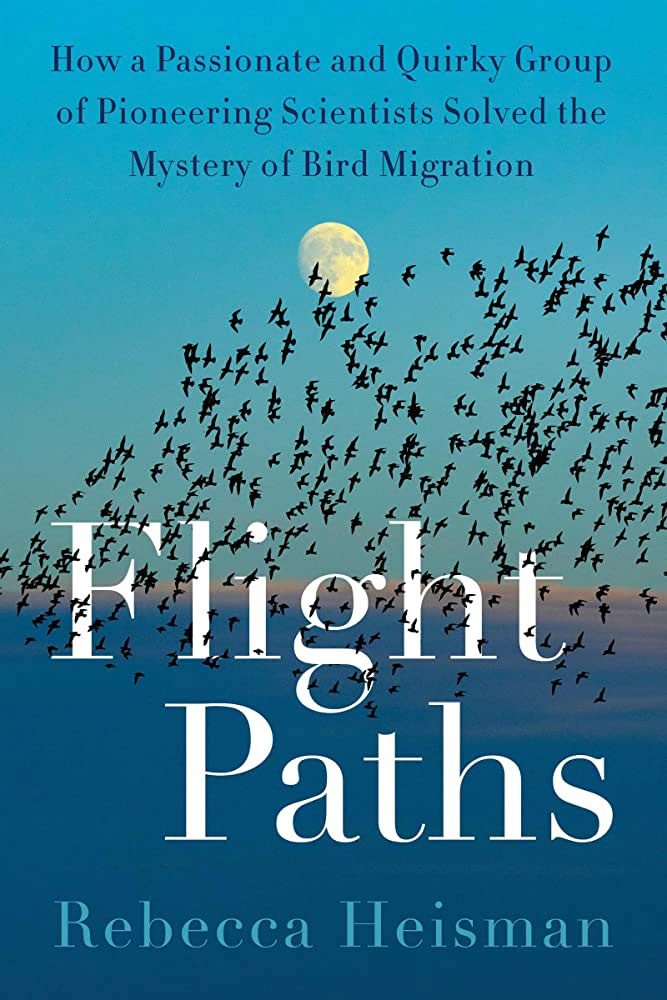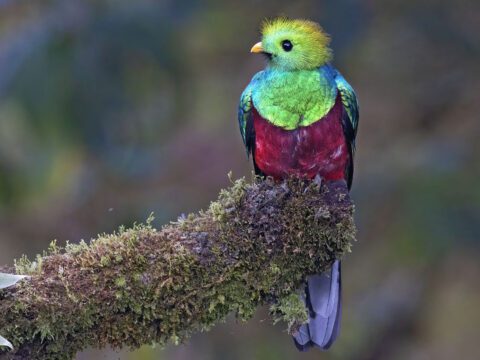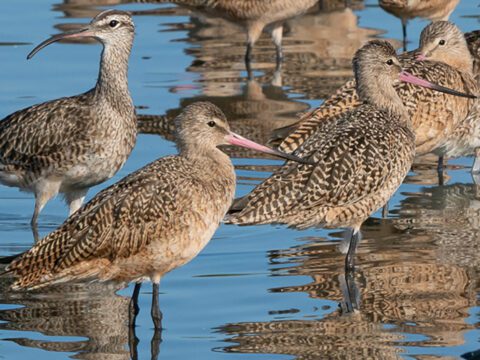Bright Lights and Big Data: Radar Ornithology and the Rise of BirdCast
By Rebecca Heisman
April 5, 2023A small group of innovative researchers cracked the secret of bird migration—and then set about applying that knowledge to save birds from the hazards of city lights.
From the Spring 2023 issue of Living Bird magazine. Subscribe now. Excerpted from Flight Paths, by Rebecca Heisman, and reprinted with permission of Harper, an imprint of HarperCollins Publishers.
Imagine you’re a Ruby-throated Hummingbird. It’s May, and after a winter spent in the tropics, you’re finally on your way home to the forests of eastern North America. Soon, instinct will compel you to build a nest, lay eggs, and hopefully pass your genes on to another generation. You’ve spent the night crossing the Gulf of Mexico, flying high above the dark water, wings beating nonstop for hours. The last of your energy reserves, built up in a feeding frenzy before you departed from the Yucatan, are nearly gone.
Ahead, dazzling lights glimmer on the horizon, and you adjust your course slightly to head toward them. Suddenly you’re over land, but instead of a forest where you can rest and refuel, below you there is nothing but asphalt. The lights you were drawn to are the high-rise office buildings of downtown Houston, which loom all around.
Disoriented, you fly into one of them.
We don’t really know why birds migrating at night are attracted to the artificial lights of cities. It may be related to how birds navigate, using the sun and stars as part of their suite of cues to help them orient in the right direction. But we do know that as many as a billion birds die in building collisions like this one every year in the United States alone.
The ideal solution would be to turn out city lights for the full length of the migration season and let the birds pass by in the darkness that evolution has prepared them for. But spring migration lasts for weeks, and shutting off the lights of downtown Houston and Dallas for weeks at a time is, sadly, not realistic. The birds don’t arrive in a uniform stream over that entire timespan, however. There are peaks and valleys in the number of birds arriving from the Gulf, as the tiny travelers adjust their schedule to take advantage of favorable weather conditions. What if we could predict in advance which nights would be quiet and which would see an avian traffic jam in the skies, and switch off the city lights exactly when it was most needed?
Enter BirdCast.
The BirdCast project began as an effort to protect migrating birds not from city lights, but from pesticides. In the late 1990s, with funding from the U.S. Environmental Protection Agency, a group of organizations and researchers including Sid Gauthreaux at Clemson University set out to develop a project that would use weather radar data to predict the intensity of bird migration in the “mid-Atlantic flyway,” a region stretching along the East Coast from North Carolina to New England. The idea was that property managers could use information from BirdCast to avoid spraying potentially harmful pesticides when especially high numbers of migrating birds would be passing through.
It was a talk by Sid Gauthreaux at the 1998 meeting of the American Ornithologists’ Union (now the American Ornithological Society) in St. Louis that drew a young ornithologist named Andrew Farnsworth to Clemson and set him on a path toward a career with radar and, specifically, BirdCast. For a few years after having finished his bachelor’s degree at Cornell University, Farnsworth was traveling and leading birdwatching tours while deciding what he wanted to do next. After a summer on the coast of Texas, watching weather radar to help figure out when large numbers of migrants would be arriving on the coast, he headed north for the conference in St. Louis hoping to connect with potential advisors for graduate school.
“Seeing Sid’s talk—it was just the coolest thing ever,” said Farnsworth, who recounted the full history of BirdCast to me over the course of multiple phone interviews. “He talked about how not only could you use radar to monitor the movements of birds, but you could look at their behavior in the air and assign their origins on the ground to certain habitats, and that was just a mind-blowing moment for me.”
After the presentation, Farnsworth approached Gauthreaux, expressing his interest in studying with him. Farnsworth arrived at Clemson just as the BirdCast project was starting, and he’s still working on its latest iteration today.
That first version of BirdCast relied on a set of equations originally developed by Gauthreaux in the 1970s to predict the amount of bird migration each day based on weather conditions. Twice a day, Gauthreaux, Farnsworth, or another graduate student gathered data from weather stations in the Atlantic flyway via the internet and input them into Gauthreaux’s mathematical model to generate a forecast. To verify the forecast, they then downloaded NEXRAD radar data and created images showing the actual amount of bird migration in the region. Each morning and evening, the forecast, analysis, and images were posted to a public website that birdwatchers and anyone else interested in migration could access.
Doing all of this with turn-of-the-millennium technology was incredibly time consuming.
“It required ingesting the data through a satellite dish on top of the biology building at Clemson, manually tending to the downloads, and then the morning after, we would have to gather those data, assemble them in this weather visualization program, make this image, and then load it to the server,” Farnsworth recalled. “If it wasn’t there, there’d be this big hole on the project website. It was all pretty intense.”
It meant Farnsworth always had to be near a good internet connection, at a time when internet access was far from ubiquitous. In fall 2000, the World Series between the New York Yankees and the Mets presented a challenge. The game was a subway series, which for a New York baseball fan is, according to Farnsworth, “basically the holy grail.” Somebody in his family knew somebody that knew somebody that could get him last-row tickets for game five. So, Farnsworth completed the Thursday post before driving from Clemson to Atlanta to catch a flight to make it to LaGuardia in time for the game that night. After spending all night celebrating the Yankees’ win at a local bar, “I went back to the airport for a 6 a.m. flight, got to Atlanta, got back in the car for a three-hour drive to Clemson, arrived literally just in time to post that Friday’s forecast.” But it was worth it—he invited a woman he barely knew at the time to go to the game with him, and today he’s married to her. Ultimately, BirdCast version 1.0 required an amount of labor that wasn’t feasible to continue indefinitely, and the original BirdCast ceased its run in 2001. It took almost two more decades for computing power to catch up with the ambitions of ornithologists.
Farnsworth completed a PhD from Cornell University in 2007 and stayed on at the Cornell Lab of Ornithology, first as a postdoctoral research associate and then in a permanent research position. The National Science Foundation had funding available for projects that would apply advances in computer science to other fields, and Farnsworth became one of the co-primary investigators on a 2010 NSF grant proposal to resurrect BirdCast.
“By that point, big data was a concept that people understood,” explained Farnsworth. “The phrase started to have meaning—we can take huge amounts of information and start to figure out how to process it. Computing power was advancing, and with that came increasing amounts of cloud-based data storage, and all of that was evolving really quickly. And all of those things were critically important to where BirdCast would go.”
Radar data had become easier to access, too. Gone were the days of the NEXRAD archives being stored on tapes.
”Even when I was a graduate student, I would have to request radar data for a certain time period, and then I’d wait a day or two, and then I’d get an email to download this big pile of data. My desk was just covered in hard drives, I had so many terabytes of data,” Kyle Horton, a long-time BirdCast collaborator who’s now a professor at Colorado State University, told me. But in 2015, NOAA partnered with Amazon Web Services to store the entire NEXRAD archive in the cloud and make it freely available for download.
“The difference is that now the data are always on tap for you,” Horton said.
BirdCast and Lights
The next breakthrough came in 2018. Benjamin Van Doren, who had worked on the project as an undergraduate at Cornell, and Horton, then a Cornell Lab postdoctoral researcher, downloaded NEXRAD data for every single evening since the system was installed. These 150,000-plus individual radar scans spanned the entire continent over a period of 23 years. Van Doren and Horton then analyzed this massive dataset to find out what weather factors—wind, air temperature, barometric pressure, etc.—predicted the appearance of big migration movements on radar. Essentially, they were following the path Sid Gauthreaux first laid out with the mathematical models he developed in the 1970s, but with a far more massive dataset and greater computing power. (Although Horton never studied directly under Gauthreaux, in professor parlance he’s Gauthreaux’s “academic great-grandson”: Gauthreaux was Horton’s grad school mentor’s mentor’s mentor.)
The main text of the resulting scientific paper, published in the journal Science in 2018, is only three pages long. But in it, Van Doren and Horton laid out a system for predicting mass movements of migrating birds on a continental scale. Their math explained almost 80% of the variation in migration intensity from one night to the next.
“Having done analysis for a while now, when you’re working a model in biology or ecology, you have certain expectations of what’s good,” said Horton. “When we got those results, we were like, oh, this is really good.”
The most important factor, as it turned out, was air temperature, probably because of the relationship between air temperature and winds favorable to crossing the Gulf. Crucially, the model Van Doren and Horton created could predict migration intensity several days in advance, using only current weather conditions.
“That just seemed like a very powerful thing, both from the standpoint of getting birdwatchers excited, but also as a real tool to do conservation with,” said Horton. “We could say, this is going to be one of the big nights in Texas or in Oklahoma or New York or wherever you are. We could predict it fairly accurately.”
Based on their analysis of the NEXRAD archives, Van Doren and Horton concluded that during peak migration, the number of birds on the move on a single night frequently exceeds 200 million. For comparison, 200 million is roughly the human population of Brazil. A nation of birds of all shapes and sizes, passing overhead as we sleep.
BirdCast may have gotten its start as an effort to protect birds from pesticides, but by this time, BirdCast scientists were turning their attention to a different threat: city lights. Even though we’re still not sure exactly why lights are so irresistible to migrating birds, radar is helping us unravel just how much of a threat those lights are. A 2018 study led by researchers James McLaren and Jeff Buler used radar data to show that city lights actually affect migrating birds’ habitat usage at a broad scale, with dense clouds of migrants descending on brightly lit cities across the country during migratory stopovers instead of settling in darker, potentially better habitat nearby. And in another big-data project that analyzed the entire NEXRAD archives, Kyle Horton and his colleagues ranked the worst cities for exposing migrating birds to light at night (Chicago, Houston, and Dallas topped the list) and determined that half of a season’s migrants typically pass through these crucial areas over just a handful of nights.
Campaigns in cities to encourage businesses and residents to turn out exterior lights during migration have been around since at least 1993. But Horton and his colleagues are working on refining these efforts, using BirdCast forecasts to identify the most critical nights, the nights when weather conditions mean that the numbers of migrants passing through will be exceptionally large. The hope is that city-dwellers who may be reluctant to give up their lights for weeks at a time will still be receptive to these “lights out alerts” and clear a darkened path for the millions of birds winging their way north on these special nights.
Residents of major cities along the Gulf Coast and elsewhere can sign up via the BirdCast website to receive alerts when a big migration night is imminent. In 2019, American National Insurance, based in the coastal city of Galveston, pledged to turn out the lights at its headquarters building, which had proved fatal for migrating birds in the past. The U.S. Fish and Wildlife Service tweets out the #LightsOut hashtag to alert its followers in advance of big nights. Even former first lady Laura Bush, who apparently became a bird lover at age 10 when she earned her bird badge for Girl Scouts, has helped promote the campaign to turn off lights in Texas cities at the height of migration.
In fall 2019, a landmark study in the journal Science announced an alarming finding: North America’s bird populations have declined by almost 30% since 1970, a loss of approximately 3 billion individual birds. NEXRAD data from 2007 to 2017 was part of the authors’ analysis. The results from the radar data showed that the biomass of nocturnal migrant birds traveling along the continent’s flyways each spring declined by 13% in that decade alone.
But there’s reason to hope. Weather radar may be helping us watch birds’ decline, but as we get better and better at pinpointing exactly where, when, and how we need to protect them during migration, it can help us save them, too.

All About Birds
is a free resource
Available for everyone,
funded by donors like you
American Kestrel by Blair Dudeck / Macaulay Library






















